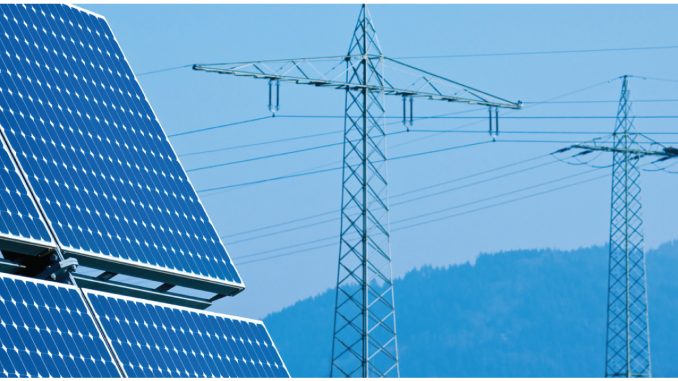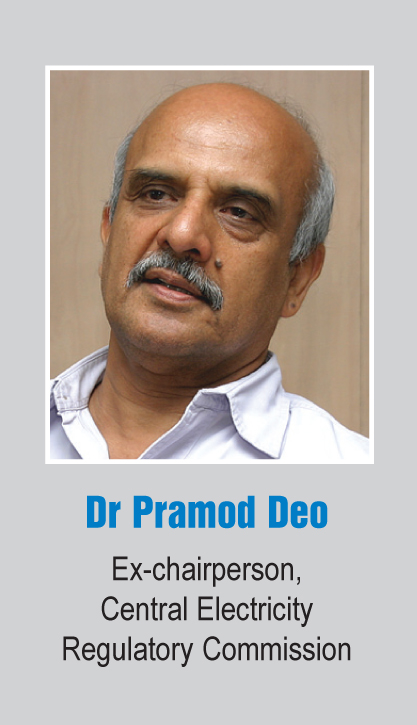
With the notification of the much-awaited amendments to the Tariff Policy, the government has achieved another milestone in power sector reforms. While the amendments mostly succeed in meeting the industry’s expectations, attention has now turned to their execution in the right spirit. Sector experts comment…
What are the key benefits that the amendments to the Tariff Policy are expected to bring to the power sector?
A key benefit of the Tariff Policy amendments is that there will be no interstate transmission charges for solar power. The policy mandates an 8 per cent renewable purchase obligation (RPO) for solar power by 2022. As the market for renewable energy develops, states with a larger renewables resource base will be able to sell electricity to power-deficit states. Looking at these amendments, the intra-state transmission charges for solar power should also be removed. This will result in the reduction of transmission costs, which are calculated on a per MW basis. For instance, with the existing intra-state transmission charges, quantum of energy despatched by a solar plant with a capacity utilisation of 17-18 per cent will be very low as compared to a conventional power plant of similar MW capacity, but it will be required to pay the same transmission charges. Waiving these charges will help solve this issue.
Many amendments in the Tariff Policy are beneficial for the growth and overall health of the Indian power sector. Some of them are:
- Entrusting state electricity regulatory commission (SERCs) with the responsibility of devising a specific trajectory for the 24-hour supply of adequate and uninterrupted power for all consumers by 2021-22 or earlier. This will help in the unbiased assessment of the required quantum and its tie-ups, thereby providing enhanced opportunities for power sale, which is currently suppressed by discoms for various reasons. Monthly or quarterly revisions of tariffs, reflecting variations in fuel prices or power purchase costs, will help reduce the burden on discoms.
- Independent power producers are now permitted a one-time expansion of 100 per cent instead of the earlier 50 per cent. This will help in the optimal utilisation of resources and open a window of opportunity for the quick ramp-up of thermal capacity without delays.
- Power plants with unrequisitioned capacity can now sell power in the open market, which will improve plant load factor and efficiencies as well as bottom lines.
- In the transmission segment, the vision of creating capacities in advance will help ease congestion and enable power flow, eliminating regional power imbalance. Competitiveness in intra-state transmission projects will help individual states develop or strengthen networks in conjunction with generation and interstate transmission growth.
- For the hydro sector, the amendments provide welcome relief in terms of the extended times available to tie up power under Section 62 of the Electricity Act, 2003. Discoms can enter into 50-year power purchase agreements (PPAs) and generators are given incentives to explore the options of long-term financing with the aim of reducing tariffs in initial years.
The most significant amendments are for the renewable energy sector, like the fixing of definitive targets for renewable generation, exemption from interstate transmission charges and the development of microgrids. They will help in the rapid development of renewables, especially solar.
Some of the welcome changes are:
- A trajectory to be devised by the regulator to ensure the objective of 24×7 supply to all is fulfilled by 2021-22. This will complement the measures taken under the Ujwal Discom Assurance Yojana and address the issue of idling generation capacities.
- Allowing brownfield capacity addition up to 100 per cent of the existing capacity under the regulated tariff route will help reduce the cost of power. This will optimise the use of land and other supporting infrastructure and bring about economies of scale.
- The increase in the percentage of RPOs, renewable generation obligations (RGOs), bundling of renewable power, exemption of interstate transmission charges and ancillary services for grid stabilisation will give an impetus to renewable capacity addition.
- The exemption of hydro projects from competitive bidding till 2022 and the extension of PPAs by 15 years will help even out tariffs over a longer period and save early tariff shocks in hydro due to high costs and long gestation periods. This will also encourage states to sign hydro PPAs and help optimise the energy mix, which is biased towards thermal.
- Regulatory clarity in composite schemes and the allowing of automatic pass-through of changes in duties, levies and cess will remove a lot of ambiguity and uncertainty for competitively bid projects. Allowing cost pass-through for imported coal/e-auctioned coal for meeting deficit coal supplies from Coal India Limited (CIL) will help reduce litigations as cases pertaining to the above issues are pending before the appropriate commissions.
- Enabling time-of-day (ToD) metering will help demand management and lead to energy conservation.
The amendments are expected to bring broad-based benefits for the economy, the sector and the consumer. They will give a major boost to the renewable
energy sector as discoms have been targeted to source 8 per cent of their total consumption from solar power by 2022. They will also ensure the compulsory purchase of power from waste-to-energy plants. The removal of charges for interstate transmission and for losses on solar and wind energy is a step in the right direction. The government’s move to specify RGOs for new coal- or lignite-based thermal plants after a specified date is another welcome step.
The amendments aim to achieve the objective of providing power to all at affordable rates. They lay down a roadmap to ensure that power can reach the remotest of villages by regulating the grid and tariffs. Allowing producers a one-time expansion at 100 per cent of the existing capacity at the same site with tariff, sale of unrequisitioned power, encouraging captive power plants and giving an impetus to renewable energy, particularly solar and hydro, are encouraging and will help the economy maintain its growth momentum.
The amendments also outline a strategy that does not compromise on environmental issues, including measures to increase renewable power generation and use treated sewage water.
The key benefits expected from the Tariff Policy amendments are:
- The generator will have the option of selling the contracted power not offtaken by discoms in the merchant market. However, 50 per cent of the profit derived from such transactions will have to be shared with the state utility.
- Provision for providing affordable power to consumers near coal mines by procuring it from coal washery reject-based plants.
- Power for remote unconnected villages through microgrids, with a provision for grid power purchase as and when connectivity is established.
- Allowing fuel price pass-through in power tariffs with plants procuring imported/e-auctioned coal.
- Increase in solar RPOs from the present 3 per cent to 8 per cent of the annual power procured by utilities.
- No interstate levy of transmission charges on renewable power generation.
- SERCs to mandate smart meters for all industrial and commercial consumers.
- Faster installation of smart meters to enable ToD metering, reduce theft and allow net metering.
- Hydro projects exempted from competitive bidding till 2022.
Do the amendments adequately address the challenges currently being faced by the sector?
Pramod Deo
The amendments do not adequately address the challenges. The tariff policy is only a guideline and reflects the central government’s good intent. The real test will be how the states fall in line with the changes. Unless their current issues are addressed and the performance of discoms improves, the amendments will be unable to bring a real change. The central government might lay down very good principles, but in the end they have to be adopted by the respective state governments to lead to results on the ground. Since almost all discoms are state owned and regulatory commissions work as per the wishes of respective state governments, the amendments might not bring the desired outcomes. A political dialogue is required between the central and state governments to ensure the efficient implementation of the policy. Since electricity is for all practical purposes a state subject, the absence of “enlightened” steps is holding back policymaking and implementation in the power sector.
K. Raja Gopal
It should be understood that the sector is currently facing multidimensional challenges on various fronts like PPAs, coal, railways, finance and environmental issues. The Tariff Policy alone cannot provide every solution. However, a genuine effort has been made by the government to resolve issues like:
- Tariff issues in sourcing alternative coal during shortfall in CIL linkage coal.
- Tariff pass-through for changes in taxes and duties.
- Removal of ambiguity in the definition of the composite scheme.
It is for the utilities and states to implement the Tariff Policy guidelines to resolve disputes and improve power availability.
A.K. Khurana
While the revised policy has stated that any changes in the domestic duties, levies, cess or taxes imposed by the central or state governments will be treated as a change in law, it has also specified that they will be treated as pass-through in PPAs, subject to the approval of the commission, unless provided otherwise. The industry feels that this leaves open a window for further delays and disputes. The best way would have been to allow these incontestable factors to be included in the tariff immediately upon the imposition of levies/duties/taxes. In case of a dispute, a truing-up mechanism could decide the quantum of increase.
Sushil Maroo
The amendments are for the betterment of the sector. However, they are not enough for addressing all the challenges faced by it.
Rajesh Mokashi
For the first time, the amendments provide for the creation of microgrids, the missing link in the distribution of power to the remotest villages. This will provide a fillip to distributed capacities (off-grid plants, mainly renewable energy) and also encourage rooftop generation. When the conventional grid reaches full capacity, excess power can be sold to the grid through net metering. The increase in the solar RPO from 3 per cent to 8 per cent in the new Tariff Policy will boost solar projects.
Allowing fuel price pass-through in power tariffs for imported coal or e-auctioned coal-based plants will enable such plants to remain viable and earn a reasonable return even when coal prices rise sharply. The fuel price variation risk will be a pass-through to the offtakers, insulating generators from losses. The introduction of smart meters, at least for commercial and industrial users, will alter their consumption pattern since tariffs will be different for peak and non-peak hours (ToD tariffs) and help discoms manage demand.
Because of the demand slowdown, discoms are resorting to the back-down of base capacities (not offtaking the contracted power under long-term PPAs). Allowing baseload stations to sell undrawn power in the merchant market (capacity that would otherwise have been backed down) will:
- Enable power generators to run plants at higher (and possibly optimal) capacity, thereby providing better cash flows and returns.
- Higher availability of merchant power in the market.
- Lower merchant tariffs (since the cost of power will be marginally less).
- Sharing profits with discoms will enable them to earn extra revenue and profits so that discom health can be improved (in a small way). However, the effective implementation of this provision needs to be ensured.
Which of the sector’s expectations have not been addressed by the amendments?
Pramod Deo
The unresolved issues pertain to power projects that have been stranded due to the coal reauctions. It is necessary to provide some special dispensation in such cases, which cannot be achieved through the Tariff Policy. Since it is only a product of the Electricity Act, it cannot supersede the substantive provisions existing under the law. For instance, the issues faced by Mundra’s imported coal projects will not be solved unless the Supreme Court’s judgment upholds the central electricity regulatory commission (CERC’s)
dispensation; they will require an amendment in the act itself. However, the Tariff Policy has taken some positive steps such as the pass-through of coal prices in the cost of power without any restrictions. This suggestion had earlier been made by the CERC but the SERCs were reluctant to implement it. Thus, it will strengthen the hands of SERCs but its success is dependent on their willingness to accept the reality that power costs will shoot up with this dispensation.
K. Raja Gopal
The amendments attempt to remove the bottlenecks in the sector for the benefit of future projects but certain legacy issues have been left unaddressed. These include:
- A resolution for untied capacities, which now stand at around 17 GW and are expected to touch around 33 GW by the end of the Twelfth Plan Period (2012-17).
- The relaxation of norms to avail of mega power benefits and fuel supply agreement conditions with respect to PPA tie-ups.
- The enactment of hydro purchase obligations to create a demand pull for hydro projects and enable them to secure PPAs.
- The states and state utilities must resolve PPA disputes in the larger interests of the sector and all stakeholders.
A.K. Khurana
Looking at the stress in the sector due to the legacy issue of under-recovered fixed and variable costs, and the ground reality that the majority of cases are still pending a resolution, the industry was expecting the government to formulate a mutually acceptable process to correct the bleeding balance sheets of developers. Unfortunately, the way things are going, the process might take its toll and many projects could actually turn into non-performing assets.
Rajesh Mokashi
While the amendments have addressed most of the sector’s expectations, their success lies in effective implementation. Installing smart meters will require capex, which will have to be incurred by the discoms. Unless the state gives grants or soft loans, it will be difficult for smart metering to take place.
Sushil Maroo
The policy could have addressed the allowing of pass-through of actual transportation costs for power plants constructed on the basis of captive coal blocks. Moreover, we need simple and straightforward changes in law that allow the procurer to increase taxes, duties and levies without going to the appropriate commission. Some critical issues that need to be addressed are the delays in regulatory processes and the lack of bidding opportunities for producers. We are awaiting more announcements on resolving issues like fuel supply for power plants by 2022, when 177 GW of renewable power will be transmitted to the grid. We would also have liked to see a comment on the prevention of assets being stranded by allowing the one-time conversion of PPAs concluded under Section 63 to Section 62 of the Electricity Act, 2003.





